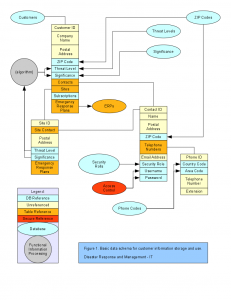O’Brien and Marakas (2007) explain the importance of disaster recovery in regards to a company’s computing resources, “Many firms could only survive a few days without computing facilities. That’s why organizations develop disaster recovery procedures and formalize them in a disaster recovery plan.” This is the basis of the business plan submitted in a subsequent assignment (Schadone, 2009) in which the focus is mitigating computing loss and recovering.
Information Technology relies on the acquisition, storage and retrieval of pertinent data. The development of a business plan leads one to require the adaptation of a data schema to manage the influx of information which could be useful to a growing company, if not required within the functioning business. Figure 1 reveals the core data schema for tracking customers and their needs. This schema is certainly not all-inclusive but provides a framework which can be built upon depending on the corporate direction and specific requirements.
This information can be utilized, obviously, to provide for the clients’ needs, but it can also be utilized to provide increased organization and specific solutions based on measured metrics. As figure 1 shows acquisition and storage of demographic information, it also allows for the assignment of specific roles. These roles can allow a portal application to provide only the most needed system monitors for each role, including role-specific alerts and notifications. Also, greeting the client by name, dependent on login data, provides an air of security prompting the user to logout when the session is complete. This demographic data can also be useful in providing personalized support by allowing support personnel access to each contact’s information and provide a basis to create a schema specific to Online Support Systems based on customer needs. Whether storing preferences or previous form entries, a personalized use of collected data can simplify processes for the user making the user more efficient in the end.
O’Brien, J. A., & Marakas, G. M. (2007). Introduction to information systems (14th ed.). New York: McGraw-Hill/Irwin.
Schadone, M. F. (2009). Disaster Response and Mitigation – IT: A Business Proposal. Minneapolis, MN: Walden University.


